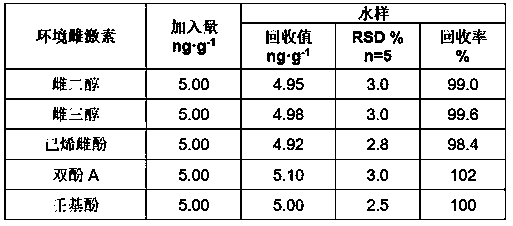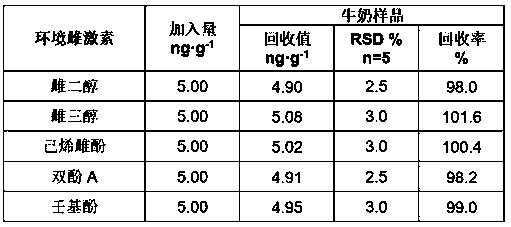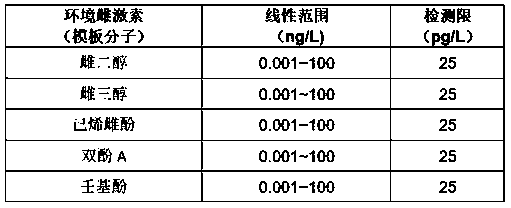Fabrication method and application of an environmental estrogen electrochemical light-emitting sensor
A technology for environmental estrogen and electrochemical analysis, applied in the field of new nano functional materials and biosensing analysis, can solve the problems of reduced sensitivity of electrochemical sensors, limited application of molecularly imprinted membranes, reduced stability and reproducibility, etc. Excellent electron transfer ability, lower detection cost, convenient operation effect
- Summary
- Abstract
- Description
- Claims
- Application Information
AI Technical Summary
Problems solved by technology
Method used
Image
Examples
Embodiment 1
[0030] Example 1 Preparation of Co-nanoarray
[0031] (1) Use dilute hydrochloric acid, absolute ethanol and deionized disposable electrode for ultrasonic cleaning to remove the oxide layer and surface impurities of the disposable electrode;
[0032] (2) Weigh 1 mmol Co(NO 3 ) 2 and 3 mmol urea CO(NH 2 ) 2 , put it into a 50 mL beaker, add 30 mL of deionized water and stir until clear, then transfer to a 50 mL polytetrafluoroethylene reactor;
[0033] (3) Put the disposable disposable electrode treated in step (1) into the solution in the reaction kettle in step (2), and react at a temperature of 100°C for 12 hours to prepare the cobalt hydroxide nanosheet array precursor body electrode;
[0034] (4) Insert the cobalt hydroxide nanosheet array precursor electrode obtained in step (3) into the phosphate buffer solution PBS containing dopamine, ammonium persulfate and cobalt nitrate, react at 20 °C for 4 hours, take it out and use Immersed twice in deionized water to prepa...
Embodiment 2
[0036] Example 2 Preparation of Co-nanoarray
[0037] (1) Use dilute hydrochloric acid, absolute ethanol and deionized disposable electrode for ultrasonic cleaning to remove the oxide layer and surface impurities of the disposable electrode;
[0038] (2) Weigh 2 mmol Co(NO 3 ) 2 and 6 mmol urea CO(NH 2 ) 2 , put it into a 50 mL beaker, add 30 mL of deionized water and stir until clear, then transfer to a 50 mL polytetrafluoroethylene reactor;
[0039] (3) Put the disposable disposable electrode treated in step (1) into the solution in the reaction kettle in step (2), and react at a temperature of 110°C for 11 hours to prepare the cobalt hydroxide nanosheet array precursor body electrode;
[0040] (4) Insert the cobalt hydroxide nanosheet array precursor electrode obtained in step (3) into the phosphate buffer solution PBS containing dopamine, ammonium persulfate and cobalt nitrate, react at 30 °C for 5 hours, take it out and use Immersed in deionized water for 3 times to...
Embodiment 3
[0042] Example 3 Preparation of Co-nanoarray
[0043] (1) Use dilute hydrochloric acid, absolute ethanol and deionized disposable electrode for ultrasonic cleaning to remove the oxide layer and surface impurities of the disposable electrode;
[0044] (2) Weigh 3 mmol Co(NO 3 ) 2 and 9 mmol urea CO(NH 2 ) 2 , put it into a 50 mL beaker, add 30 mL of deionized water and stir until clear, then transfer to a 50 mL polytetrafluoroethylene reactor;
[0045] (3) Put the disposable disposable electrode treated in step (1) into the solution in the reaction kettle in step (2), and react at a temperature of 130°C for 9 hours to prepare the cobalt hydroxide nanosheet array precursor body electrode;
[0046] (4) Insert the cobalt hydroxide nanosheet array precursor electrode obtained in step (3) into the phosphate buffer solution PBS containing dopamine, ammonium persulfate and cobalt nitrate, react at a temperature of 40 °C for 6 hours, take it out and use Immersed in deionized wate...
PUM
 Login to View More
Login to View More Abstract
Description
Claims
Application Information
 Login to View More
Login to View More - R&D
- Intellectual Property
- Life Sciences
- Materials
- Tech Scout
- Unparalleled Data Quality
- Higher Quality Content
- 60% Fewer Hallucinations
Browse by: Latest US Patents, China's latest patents, Technical Efficacy Thesaurus, Application Domain, Technology Topic, Popular Technical Reports.
© 2025 PatSnap. All rights reserved.Legal|Privacy policy|Modern Slavery Act Transparency Statement|Sitemap|About US| Contact US: help@patsnap.com



